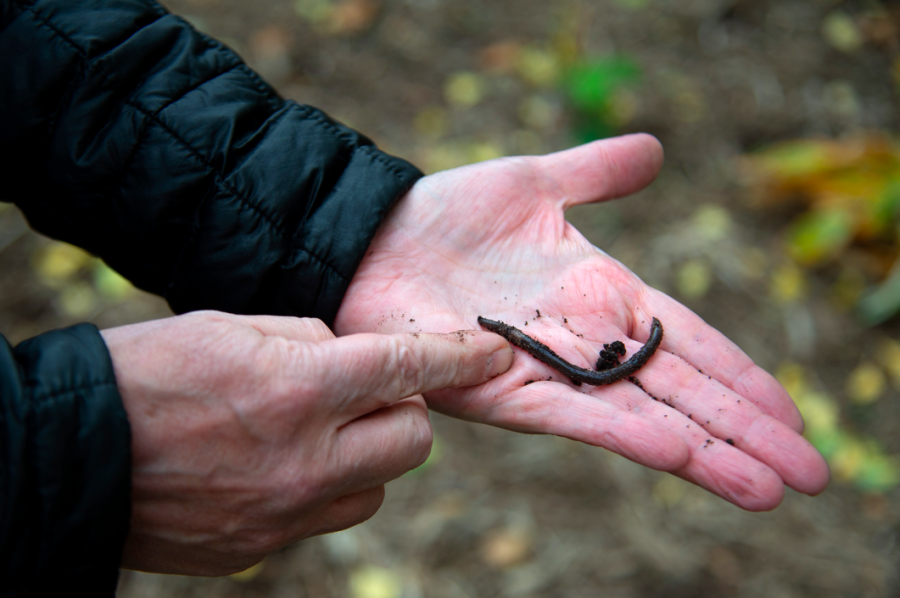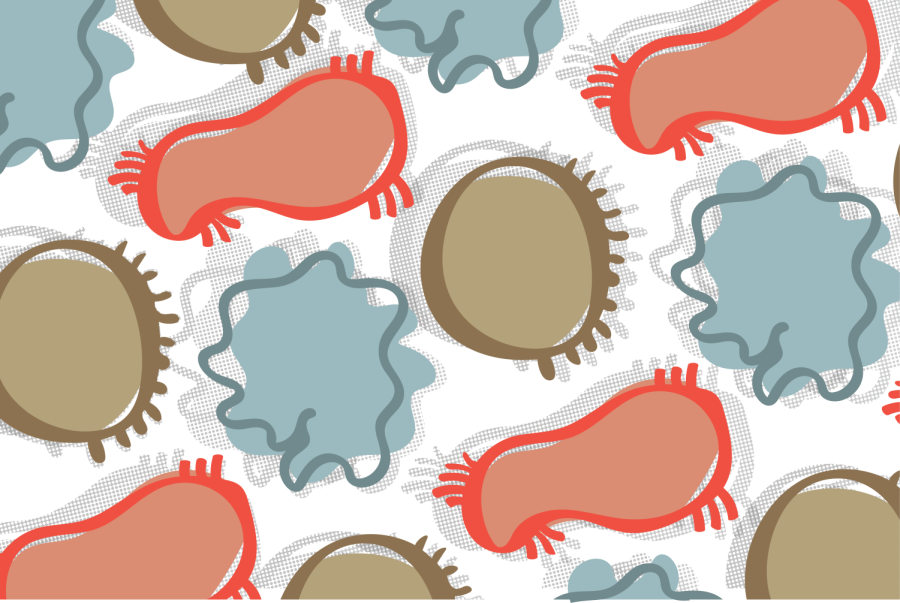Under the yellow leaves of a large ginkgo tree on the University of Minnesota St. Paul campus, Lee Frelich moved his shoe around in the dirt, looking for jumping worms crawling around a couple inches below the surface layer of mulch. Spotting one, he reached down and pulled it from the soil, watching it twitch and wiggle in his hand.
Although only four to five inches long, jumping worms are wreaking havoc on garden beds around the Twin Cities area. Characterized by their metallic sheen and a snake-like movement that gives them their name, jumping worms are one of the newest invasive species in Minnesota, spreading around the Twin Cities metro in recent years.
Frelich and a team of soil scientists and invasive species experts are a year into a three-year project seeking to understand how the worms spread and survive in cold climates and where they have crawled so far. Funded by the Minnesota Invasive Terrestrial Plants and Pests Center, the team is also getting help from people who have spotted the worms in their gardens or other areas of the city and have uploaded photos to their website along with their locations.
“It’s kind of exciting because we know virtually nothing about this invasion,” said Frelich, the principal investigator of the project. “Everything we find is new.”
The worms usually start dying after the weather cools, around September or mid-October, he said. Their eggs are laid cocooned in the dirt to survive cooler temperatures. Although the researchers do not know yet what temperatures jumping worm eggs can withstand, Frelich said he has noticed worms coming back to mulch beds in St. Paul since discovering them on campus in 2019.
Jumping worms, originally from East Asia, are distinctive from regular European earthworms on a couple of fronts, Frelich said. For one, instead of eating, digesting and excreting dirt that can easily be compacted together, jumping worms turn the excreted soil into tiny granular clumps, reminiscent of coffee grounds or cat litter. This has significant environmental impacts and can even result in the loss of an entire forest, he said.
When soil is granular like that, it is harder for plants and trees to take root in the soil. The soil is also more easily washed away because it does not stick together. Heavy rains then deposit the soil at the bottom of hills and can leach into rivers, altering the landscape significantly. And when the soil gets washed away, the nutrients get washed away too.
“There’s big potential for huge, huge damages here,” Frelich said.
He said forests can lose tons of nutrients per acre over the years, and although they have to do more tests, he predicts the worms will keep turning soil into granules until they get to the glacial material underneath.
When it gets to this stage, the “ecosystem will literally have lost everything and cannot be a forest anymore,” Frelich said. This can be especially damaging in southern Minnesota where the soil has glacial sand and gravel underneath it that does not have anywhere near the same capacity to hold nutrients as the silt soil above.
He predicts based on the number and location of sightings around the cities, the worms will infest the whole metro area within four to five years.
The worms can spread via potting soil and mulch, shared plants, fishing or on the underside of boots or bike tires, he said. They can also inch across forest floors up to 50 to 100 feet in a rainy year and can even move across concrete when conditions are wet, Frelich said.
Because the Minnesota Landscape Arboretum used to put wood chips from the an infected pile on all their garden beds, walking paths and trees, jumping worms have spread to nearly everywhere on the property, said Erin Buchholz, an integrated test management specialist who treats pests at the arboretum.
Already, she has seen the impacts of erosion washing down hilly slopes. Wild turkeys who eat the worms scratch up the dirt and contribute to erosion as well, she said.
Kyungsoo Yoo, a co-principal investigator on the project and University professor, said the team thinks the worms’ progress could be stoppable. Their study comes at a crucial time where the worms have not yet spread throughout the state.
Volunteers interested in science are participating in the effort through the “Worm Rangers” program, run out of Boulder Lake Environmental Learning Center, a partner with the University of Minnesota Duluth. Around 420 people have submitted photos so far, said Ryan Hueffmeier, director of the center. People can submit jumping worm data here.
Although they have focused in Rochester, St. Cloud, Duluth and the Twin Cities, Hueffmeier said their goal is to expand the research around the state, especially in south and southwest Minnesota where they do not have any recorded cases.
“We really want to get people out there looking to understand fully where they are and where they’re not,” he said. “Southeast of the metro area is really getting hammered, that’s where almost all of our reports are, and just south of St. Cloud is our furthest northern report yet.”






















